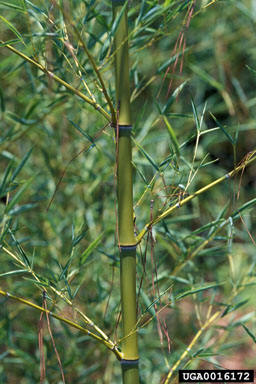
Plants: Golden bamboo (Phyllostachys aurea PHAUS), and other invasive bamboos (Phyllostachys spp. and Bambusa spp.) are perennial grass species native to Asia that form infestations.
Identification: Canes are 1 to 6 inches in diameter, golden to green to black, with wiry branches from joints. Leaves are grass-like and stems are hollow between solid joints, while lower shoots and branches have loose papery sheaths that cover the ground when shed. From 16 to 40 ft tall, this grass has bushy tops of lanceolate leaves in fan-like clusters that are often golden green. Plants generally arise from branched rhizomes. Flowers and seeds are very rare and usually not seen.
Ecology: Widely planted as ornamentals for fishing poles around old home sites, bamboos are now escaped exotics. Colonizes by rhizomes, infestations rapidly expand with disturbance. A general dieback can occur periodically after flowering and seeding (about every 7 to 12 years), resulting in standing dead canes and new shoots.
Herbicide Control: Apply thoroughly a 42+% active ingredient of imazapyr herbicide (Arsenal AC, Vanquish, or Polaris AC) as a 1% solution (4 ounces per 3-gal. mix) in water with a surfactant (methylated seed oil, basal oil, or vegetable oil) at a 1% solution (4 ounces per 3-gal. mix). If damage to non-target vegetation is a concern, use a 41% active ingredient of glyphosate herbicide (Accord, Razor, Roundup Original, or Buccaneer) as a 10% solution (1 quart per 3-gal. mix) in water with a surfactant at a 1% solution. A combination of the two herbicides in water with a surfactant may be the most effective. Spray all foliage in September or October, with multiple applications to re-sprouts. For tall bamboo stems, cut just above ground level between stem sections and immediately apply the same herbicide or herbicide mixture at twice strength into stem cup.
Warning: Herbicides containing the active ingredient imazapyr (Arsenal AC, Vanquish, Polaris AC, etc.) can damage plants with roots in the treated area. Always read and follow label instructions carefully.
Photo and Text Credit: (A Field Guide for the Identification of, A Management Guide for) Invasive Plants in Southern Forests, James H. Miller, USDA Forest Service, 2010, ForestryImages.Org
Additional Resources